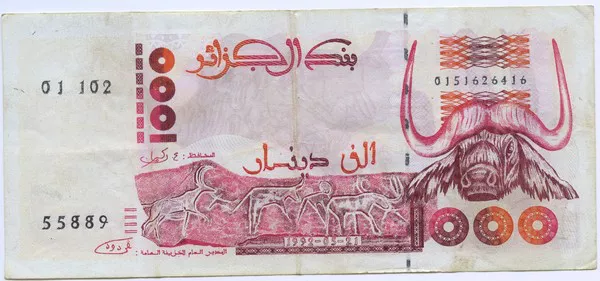Currency notes are not merely pieces of paper; they are symbolic representations of a nation’s history, culture, and aspirations. The 1000 Algerian Dinar note, with its intricate design and carefully selected imagery, is no exception. In this exploration, we delve into the elements that grace this banknote, unraveling the rich heritage woven into its fabric.
Historical Context
Issued by the Bank of Algeria, the 1000 Dinar note has undergone various design changes since its introduction. The current version, introduced in 2018, stands as a testament to Algeria’s historical journey and its vibrant cultural identity.
Front Side: A Glimpse into Algeria’s Landscape
The front side of the 1000 Dinar note paints a vivid picture of Algeria’s diverse geography. At the center, the imposing structure of the Ketchaoua Mosque in Algiers, the capital city, takes pride of place. This UNESCO World Heritage site is not only a symbol of religious significance but also a representation of Algeria’s enduring cultural legacy.
Surrounding the mosque, the design incorporates images of the Assekrem Peak in the Hoggar Mountains. This mountain range is not only a geographical landmark but also holds cultural importance, as it is associated with the Tuareg people, nomadic inhabitants of the Sahara Desert.
The left side of the note features the striking desert landscape of Tassili n’Ajjer, another UNESCO World Heritage site known for its prehistoric rock art. This choice reflects Algeria’s commitment to preserving its cultural and natural treasures.
Back Side: Celebrating Algeria’s Cultural Heritage
Flipping the note reveals a celebration of Algeria’s rich cultural heritage. The intricately designed patterns pay homage to the nation’s traditional crafts, including the famed Berber carpets. These carpets are not only artifacts of immense artistic value but also repositories of Berber cultural narratives.
The central image on the reverse side features the impressive Beni Hammad Fort, an archaeological site that echoes the historical legacy of the Hammadid dynasty. Constructed in the 11th century, the fort stands as a testament to Algeria’s medieval past and architectural prowess.
Symbolism and Significance
Islamic Heritage: The prominence of the Ketchaoua Mosque on the front side emphasizes Algeria’s Islamic heritage. As a nation where Islam is a predominant religion, the inclusion of religious architecture reflects a crucial aspect of the country’s identity.
Cultural Diversity: The diverse landscapes showcased on the note, from the bustling city of Algiers to the tranquil deserts and mountains, underscore the cultural richness and geographical diversity that define Algeria. It is a nod to the coexistence of urban life and the nomadic traditions that form the nation’s cultural mosaic.
Preservation of Heritage: The inclusion of UNESCO World Heritage sites, such as the Ketchaoua Mosque, Tassili n’Ajjer, and Beni Hammad Fort, serves as a commitment to preserving Algeria’s cultural and natural treasures for future generations.
Berber Identity: The representation of Berber carpets and the mention of the Hoggar Mountains are a tribute to the Berber population, emphasizing the importance of preserving their language, traditions, and unique way of life.
Historical Continuity: The image of the Beni Hammad Fort underscores the historical continuity of Algeria, reminding citizens of the enduring legacy of past civilizations and the importance of preserving and learning from this history.
Security Features
Beyond its aesthetic and cultural significance, the 1000 Dinar note incorporates advanced security features to prevent counterfeiting. These features include holographic elements, watermarks, and intricate patterns that add layers of complexity to the design.
Conclusion
The 1000 Algerian Dinar note is not merely a medium of exchange; it is a canvas that tells the story of a nation. From the architectural marvels of its cities to the vast expanse of its deserts and mountains, every element on the note contributes to the narrative of Algeria’s history, culture, and identity. As citizens carry this banknote in their daily transactions, they also carry with them a piece of their nation’s rich heritage, a tangible connection to the stories that have shaped Algeria into the diverse and resilient country it is today.


